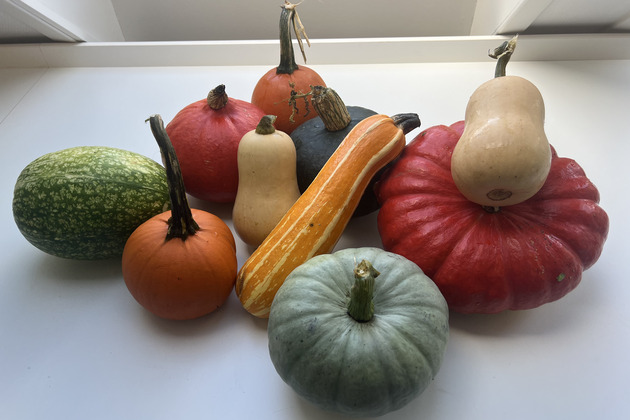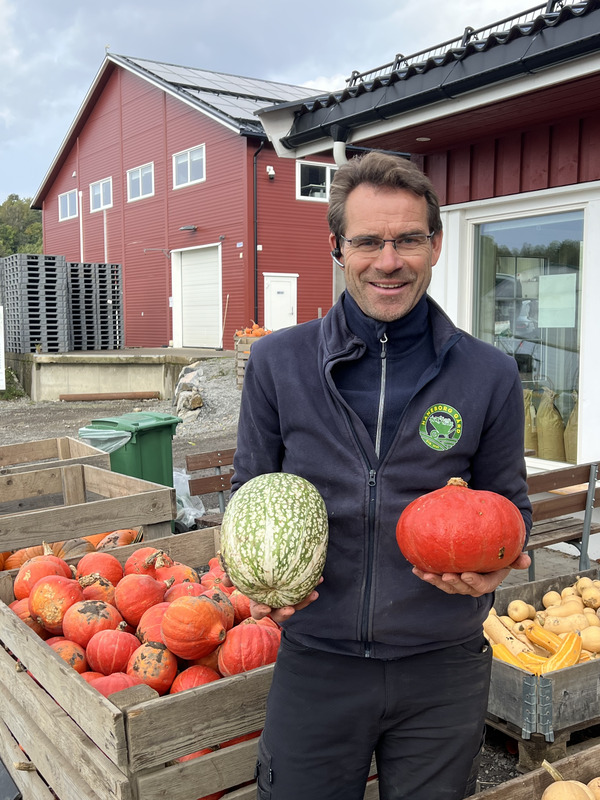Sensory research captures the distinct character of pumpkins

Sales of edible pumpkins are on the rise, and more varieties are now being cultivated in Norway. With Nofima’s new sensory analyses, producers gain a concrete tool for describing quality and flavour, helping customers choose the pumpkin variety best suited to their needs.
In short:
- There are many pumpkin varieties differing in flavour and texture. Nofima’s sensory assessors have evaluated seven of them.
- For pies, soups or purées, the recommended varieties are Butternut, Uchiki Kuri Hokkaido, Yellow Marrow, and the traditional Halloween pumpkin.
- For stews, roasting or as a meat alternative, the preferred varieties are Cinderella Rouge vif d’etampes, Sweet Mama Hokkaido, and Crown Prince.
- The sensory assessors applied a new sensory technique, known as sensory ethnography, to capture the origin and authenticity of each product. They evaluated and described the pumpkins’ appearance, shape, weight, taste, texture, and aroma.
The varieties evaluated were Rouge vif d’etampes, Yellow Marrow, Sweet Mama Hokkaido, Uchiki Kuri Hokkaido, Crown Prince, Halloween, and Butternut. They were all sourced from Haneborg Farm near Drøbak, outside Oslo.

Initially, the assessors examined the whole pumpkins raw. Then, each was halved and oven-baked for 30 minutes with the cut side facing down.
“This resulted in well-baked pumpkins where the natural flavour came through clearly,” says project manager Gard Wigdahl Karlsnes at Nofima.
Decorate first, eat later
Pumpkins can serve as decorative symbols of autumn and harvest, representing the transition from summer to winter and the celebration of natural food enjoyment.
Large, flat Cinderella pumpkins with red and orange “segments” give a vivid autumn impression, while the Crown Prince variety provides a softer, elegant touch with its pale green, textured skin. The elongated Yellow Marrow and pear-shaped Butternut contribute shapely variations to an arrangement, while the round, compact Sweet Mama, Uchiki Kuri, and small Halloween pumpkins add colour contrasts, whether grouped or displayed individually.
As Halloween pumpkins grow, their hollow centre expands – making them ideal for carving spooky faces or festive motifs.
Thanks to their long shelf life, pumpkins are easily repurposed once they have completed their decorative purposes. Bake them, cook them, or freeze them in smaller pieces for later use – preventing food waste and enabling convenient cooking.
Pumpkins in stews, soups or pies
Nofima’s sensory assessors documented clear sensory distinctions among the seven varieties.
“Cinderella Rouge vif d’etampes, Sweet Mama Hokkaido, and Crown Prince all have a sweet character and a drier, firmer texture. This means they hold their structure well in dishes such as stews or bakes, where they can replace or complement meat,” explains Karlsnes.
Cinderella Rouge vif d’etampes has notes reminiscent of carrot and sweet potato. Sweet Mama offers earthy notes, while Crown Prince brings a subtle fruit and berry nuance to its gentle sweetness.
“For pumpkin pies, soups, or purées, it’s better to choose varieties like Butternut, Uchiki Kuri Hokkaido, Yellow Marrow, or the traditional Halloween pumpkin,” adds Karlsnes. “They are softer, more succulent, and easier to mash – releasing moisture and developing a creamy consistency.”
Butternut provides a sweet flavour with hints of root vegetables and nuts. Uchiki Kuri is buttery and aromatic, Yellow Marrow mild with honey and caramel tones, while Halloween pumpkins offer an earthy sweetness with broth-like notes.
A promising future for Norwegian pumpkins
Accurate sensory descriptions provide producers with a refined language for promoting pumpkins. Moving beyond simple terms such as “sweet” and “nutty” helps customers identify the right variety for specific uses. Sales are already expanding beyond the Halloween season, and clearer product descriptions could accelerate this trend.
With warmer temperatures and a longer growing season, Norway may soon support an even wider range of pumpkin varieties. Farmers and home growers alike are increasingly discovering the vegetable’s versatility.
Haneborg Farm near Drøbak is one farm leading this development. Farmer Ole Martin Tomter has cultivated pumpkins for fifteen years, expanding his selection in step with increasing demand.

“This year, we sold pumpkins worth around NOK 650,000 – and we could have sold far more if production had been higher,” he says. Social media can influence sales quickly; when a customer shared a photo of the Sweet Mama pumpkin, Asian customers flocked to the farm the next day. Many consumers with foreign backgrounds have distinct preferences: Sweet Mama is popular among Asian customers, while Crown Prince is favoured by Eastern Europeans.
Haneborg Farm also grows many other vegetables. Each autumn, customers can choose from around sixty varieties, with several available for direct picking during the self-harvest season.
New sensory method offers competitive edge
In testing the new sensory ethnographic method, Nofima’s sensory assessors visited Haneborg Farm with senior scientist Ragnhild Eg. She is part of the team refining this innovative sensory approach, which encompasses the sensory experience of food — not only flavour, but also sound, sight, and touch.
“The assessors used the method to describe their first impressions of the pumpkins — how they looked, how heavy and rough they felt in the hand, and which aromas could be sniffed from the skin and stem,” Eg explains.
Afterwards, the assessors evaluated the same pumpkins baked, focusing on what they could see, smell, and taste. The team also explored the farm and its surrounding fields to all sensory impressions from their place of origin.
Sensory ethnography provides both producers and consumers with a more nuanced language to describe and select pumpkins. The contextual descriptions help convey product origin and authenticity. For producers, this offers stronger marketing potential, and for customers, it makes it easier to find the variety that matches their needs.
Contacts
Research areas
Sensory sciences
Topics
Vegetables
Research facilities

